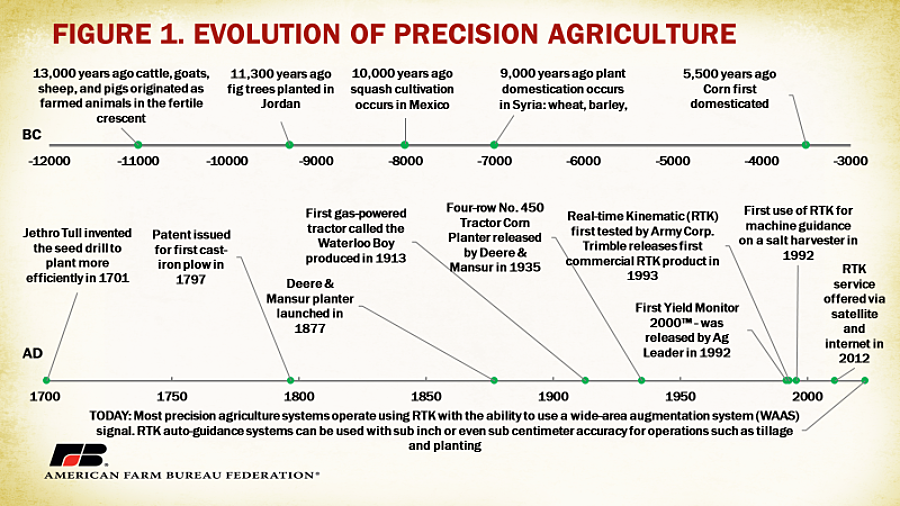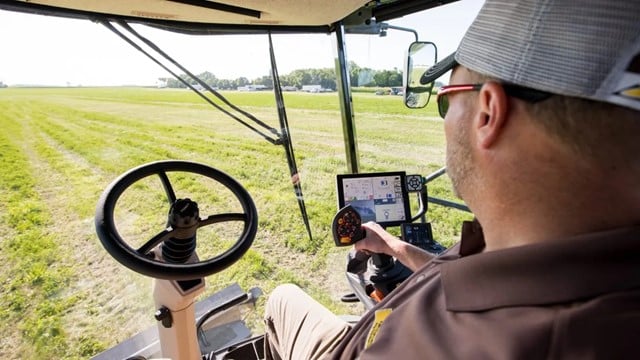Farming is truly a special walk of life. As the saying goes, “Man – despite artistic pretensions, his sophistication, and accomplishments, owes his existence to a 6-inch layer of topsoil and the fact that it rains.” Farmers tap into biology, using soil, sun, water and nutrients that have existed for millions of years to produce food that sustains people all over the world. One aspect of farming that is often overlooked is the evolution of agricultural technology.
Advancements in knowledge, biology and technology have allowed farmers to produce more food with fewer resources for 12,000 years, though the technological advancements of recent decades make the gains of the previous 11,000 or so years seem small. When agriculture began at the end of the Stone Age, the world had approximately 5 million people to feed, and few, if any, farmers were feeding people beyond their extended family. Farmers today use technology to plant and harvest mile-long fields with equipment guided by satellites for sub-inch accuracy, allowing them to feed nearly 8 billion people across the world with fewer resources than ever before.
This American Farm Bureau Market Intel will dive into the evolution and importance of precision agriculture and how policy can help to continue the research, development and adoption of the technology farmers need to continue to feed our growing population using fewer inputs and conserving our natural resources.
Beginnings
The term “precision agriculture” means managing, tracking or enhancing crop or livestock production inputs, including seed, feed, fertilizer, chemicals, water and time, at a heightened level of spatial and temporal accuracy to improve efficiencies, commodity quality and yield, and positively impact environmental stewardship.
To understand advancements in precision agriculture technology, we have to start at the beginning when precision agriculture wasn’t yet guided by GPS. Dr. Pierre Robert, sometimes referred to as “the father of precision agriculture,” conducted some of the earliest research on soil variability. In 1983, Dr. Robert was the first to research variable rate fertilizer spreading, which acknowledges that different areas of a field have different crop yields and thus have different nutrient requirements to obtain optimal yields. This understanding eventually led to the variable rate field management systems that farmers use today. According to a publication by USDA’s Economic Research Service, variable rate technology (VRT) is used to plant between 5-25% of total U.S. planted acreage for winter wheat, cotton, sorghum and rice.
Through much of the 1990s, data was gearing up to become the new crop of the 21st century. Now farmers just needed a method to gather information more efficiently. The first yield monitor, created in 1992, did just that. Yield monitors allowed farmers to record observable changes in crop yields throughout an entire field. This data could be paired with grid sampling, taking soil samples from grid points mapped out on a field to create a map of input adjustments needed to improve yields.
Advancement – pairing GPS with field variability
The remaining piece of the puzzle was how to make applying variable rate technology more efficient. GPS auto-guidance systems revolutionized the way farmers operate machinery. The first GPS auto-guidance system was usedon a salt harvester in 1996. By the early 2000s precision farming began to pick up speed. According to the previously referenced ERS report, today, the majority of corn, cotton, rice, sorghum, soybeans and winter wheat acres are planted using auto-guidance. These guidance systems are the foundation of precision agriculture across all brands of equipment and electronics that are used to produce food, fiber and renewable fuel for the world.
GPS systems are environmentally friendly and allow for more efficient use of inputs. These technologies deliver exactly what a plant needs, exactly where it’s needed, reducing waste and runoff that would be the result of excessive use. Thanks to auto-guidance systems that allowed a GPS signal to steer tractors with pinpoint accuracy, this can all be done while simultaneously gathering and recording field data.
Precision Agriculture Today
Most precision agriculture systems operate today using real-time kinematic (RTK) positioning signals. These satellite signals use measurements from the signal’s carrier wave in addition to information sent from a base station to correct errors in positioning for sub-inch or even sub-centimeter accuracy. These systems are also capable of using a wide-area augmentation system (WAAS) signal with 6–8-inch accuracy as a backup if RTK is having problems.
RTK can be used for field operations such as tillage, planting, harvesting, spraying and a wide range of other field activities. This technology is used to collect data relating to soil temperature, soil moisture, seeding depth, seeds per acre, yield and more while a farmer carries out normal operations. This data is accumulated and can be used to provide production performance over time. Topography data can even be gathered and used to design tile drainage systems that help more efficiently manage water.
Precision agriculture allows farmers to deliver exactly what a plant needs, exactly when and where it needs it and in the exact amount. This increases efficiency for chemical and fertilizer use and helps avoid excess application, making it more environmentally friendly. Chemicals aren’t wasted and fertilizer is utilized by the plant rather than empty space where roots are not able to reach. In addition, utilizing less inputs means more efficient use of money, which in turn helps farmers’ bottom lines.

Cost
RTK signals can be accessed via satellite or internet connections. But what does it cost to deploy a private system like this on a farm? CoBank published a report in May 2022 that estimates the upfront cost of a private wireless 5G system with precision agriculture capabilities would be about $55,000. This includes costs such as Radio Access Network (RAN) equipment, a base tower and labor. In addition, there are recurring costs such as subscriptions that require an additional $6,000 annually.
With the cost of precision agriculture technology, it’s more important than ever to be sure it works properly. When these systems work, they are more effective and efficient than ever. However, when things go wrong, downtime is expensive, and it often takes expertise to troubleshoot problems. Access to technicians is as important to operation as the satellites used to deliver the signal.
Policy Considerations:
Connectivity
The farm bill is critically important to bringing connectivity to the rural areas that most American farmers call home. Farmers need access to resources to use precision ag technologies. Setting up a private network is expensive and comes with recurring costs for things like subscriptions. And that’s if the farm’s location can access these resources. According to a report by USDA’s National Agricultural Statistics Service, nearly 20% of U.S. farms lacked access to broadband internet in 2021.
Title VI of the farm bill is Rural Development. This title, among other things, authorizes programs that help provide broadband access to unserved and underserved areas across the United States. People who live in places with smaller populations or geographic isolation often struggle with access to services and other economic development hurdles that those living in more urban communities do not. Access to services such as broadband internet is also essential to using precision agriculture technology and employing all the private and public benefits that flow from that technology.
Lawmakers highlighted the importance of precision agriculture by including the Precision Agriculture Connectivity Act of 2018 in the 2018 farm bill. This legislation created a task force housed at the Federal Communications Commission to focus on the connectivity and technology needs of precision agriculture. The task force established four working groups charged with researching and developing recommendations to address current challenges in connectivity. For more details on the task force and its findings click here.
Introduced on July 26, 2023, the Linking Access to Spur Technology for Agriculture Connectivity in Rural Environments (LAST ACRE) Act (S. 2542) would establish a new Rural Development competitive grant and loan broadband program dedicated specifically to extending connectivity to farms and ranches. The program would allow eligible farmers and ranchers to work with internet providers to submit bid applications for projects.
Cost Assistance
As addressed earlier, the upfront costs can be a major hurdle to farmers adopting precision agriculture technology. These investments offer returns over time, but it can be difficult to sacrifice the necessary capital when income is tight, and operational costs such as land rent are higher than ever before. Thankfully there is assistance available to help overcome these obstacles.
The Precision Agriculture Loan Program (PAL) Act (S. 719/H.R. 1495) is a bipartisan bill that would establish a loan program within the Farm Service Agency to help farmers purchase precision agriculture equipment. This would be the first federal loan program dedicated specifically to precision agriculture and would provide loans to farmers at interest rates of 2% or less with terms ranging from three to 12 years. These loans cover any precision agriculture technology that improves efficiency or reduces inputs.
The Producing Responsible Energy and Conservation Incentives and Solutions for the Environment (PRECISE) Act (S. 720/H.R. 1459) is another bipartisan bill that would expand farmers’ access to precision agriculture tools through existing USDA programs including the Conservation Stewardship Program and Environmental Quality Incentives Program.
Summary & Conclusions
As the world population grows there is constant demand for farmers and ranchers to produce more food with fewer resources. Technology has helped to propel farmers forward faster than ever before. It is monumentally important to support technology in agriculture and its adoptability in the rural communities where most farming takes place. Proposed policy would provide robust resources for rural communities to access assistance when needed and provide education to become literate in using emerging farming technologies.
###
AFBF – Market Intel


